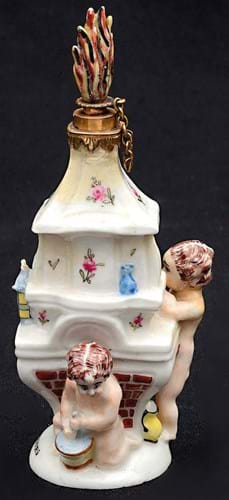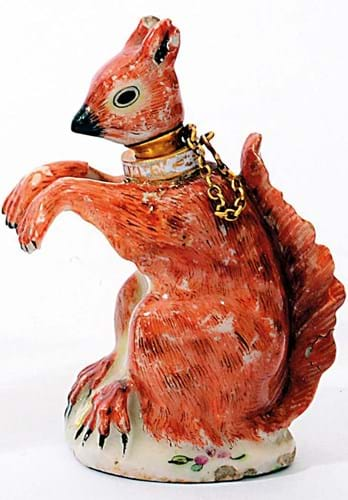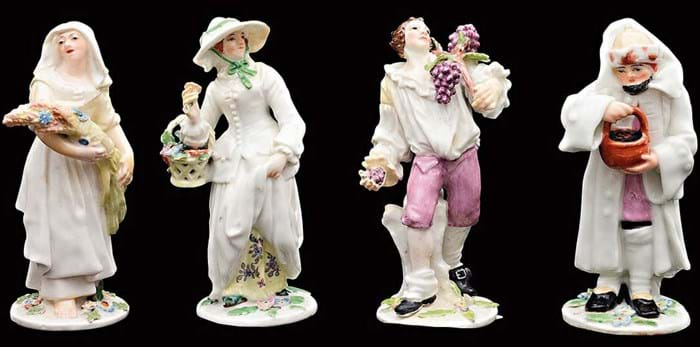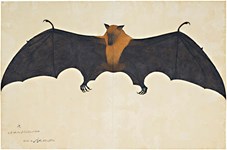The Catherine Southon (24% buyer’s premium) sale held at the Farleigh Golf Club in Surrey on November 17 included a local collection of 11 English porcelain scent bottles dating to the 18th century – most of them assembled by a family member in the post-war era.
At the time the scholarship surrounding English porcelain was moving at a pace.
When in the 1950s-60s these pieces were collected, most of these ‘toys’ were thought to be the products of the Chelsea porcelain works or a shadowy enterprise known as the ‘Girl in a Swing’ factory.
The name (a reference to an enigmatic white-glazed figure in the Victoria and Albert Museum) was used for decades to described the products of an unnamed factory until evidence emerged of a porcelain works that operated in another uber-fashionable area of Georgian London.
Bernard Dragesco’s research was published in 1993.
The 'Chelsea Toys'
The St James’s concern (the precise location of the factory is unknown) was run between c.1748-59 by Charles Gouyn (d.1785), a jeweller and erstwhile senior partner with Nicholas Sprimont at Chelsea, who chose as his stock in trade the novelty trinkets previously known simply as ‘Chelsea Toys’.
Several similar collections have recently come to market in the regions. Dreweatts sold 13 bottles in February 2020 and Sworders another dozen in 2016, including (for £8200) a gold-mounted bottle modelled as Harlequin.
Another version of this handsome bottle, modelled with the commedia dell’arte character holding a cup of wine while standing next to a barrel was offered by Catherine Southon. In good condition save some slight wear to the ‘patchwork’ enamels, it was estimated at £2000-3000 and it took £5000. Other broken and examples sold in London recently have made considerably less.
A particularly rare bottle, also by Gouyn, was that moulded in the form of a seated red squirrel. It holds its front paws up as if begging – a different guise to another St James’s model of a squirrel holding a nut, that one copied directly from a Chelsea ‘Triangle Period’ model – and perhaps one of Gouyn’s earliest independent productions after his split from Chelsea in 1747.
This piece was not in great condition (the ears were chipped and both paws had been broken and restuck) but it nonetheless made £5000.

St James’s (Charles Gouyn) scent bottle modelled as putto operating a furnace – £2600 at Catherine Southon.
Two bottles, one by St James’s one by Chelsea, sold at £2600. The former, with restoration now discoloured, was moulded as a putto pumping bellows at a furnace while the latter (with small wear and losses to encrusted flowers) modelled as two billing doves c.1755. The collection totalled just shy of £25,000.
Embryonic period
The focus of today’s collecting energy is very much on pieces from this embryonic ‘1755 and earlier’ period.
From the same vendor was a set of four Chelsea Red Anchor period figures from the set known as the Rustic Seasons.
This comical quartet was copied (probably by the Low Countries-born sculptor Joseph Willem) from Meissen exemplars (they are also known at Longton Hall). The Metropolitan Museum of Art dates its set, part of the Irwin Untermyer gift in 1964, to 1753-55.
Much of the distribution of Chelsea and other English porcelain was through the ‘chinamen’ category of dealers and retailers and via annual auctions of the type that had been used by the East India Company for many years prior.
The Chelsea Sale Catalogue for March 14, 1755, lists these models under lot 57 as ‘four small figures of the seasons for desart’
Occasional singles appear for sale (historically for £2000-4000 each but today more likely £800-1200). A full set is a rarity. Three of the figures had received modest to heavy restoration that had discoloured but they made a decent £6600.

















